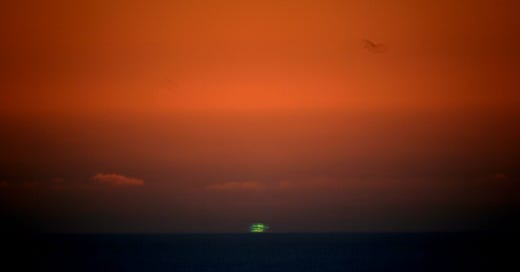What is all of this nonsense about the sun turning green at sunset? If you're thinking this sounds like a myth or optical illusion, you're not alone. When I first moved to the west coast, I dismissed the green flash as another surf legend, like the idea of the perfect wave or that people who strap wavestorms onto their Tesla aren’t unpleasant to be around. But on a clear winter evening, I witnessed it myself - a brilliant emerald burst as the sun vanished into the Pacific

The green flash isn't your eyes playing tricks after staring at the setting sun (though please don't do that). It's actually caused by our old friend refraction, the same physics that makes waves wrap around points and break parallel to the coastline. But to understand why the sun briefly turns green, we need to understand how light travels through our atmosphere.
Light from the sun comes in packets called photons, which have some peculiar properties. They're massless yet can bend around massive objects like stars and planets due to gravity. While this gravitational bending is real, it's not what causes the green flash. Gravity bends all colors of light equally, like how a prism separates white light into different colors by its wavelength/frequency, not by its weight.

The real magic happens because of our atmosphere. Like the ocean, our atmosphere is stratified - meaning the air gets thinner as you go up, creating layers of different densities. When sunlight hits these layers, it bends just like waves do when they hit shallow water. But unlike gravity, our atmosphere bends different colors of light by different amounts.
nk of it like waves approaching the shore at an angle. Just as longer period swells wrap around obstacles and towards the coast differently than short period waves, different colors of light bend at slightly different angles as they pass through our layered atmosphere. Red light, with its lower frequency, bends less than green light. This means that as the sun sets, the green light can curve around Earth's surface just a bit more than the red, allowing us to see it for a fraction of a second longer.

This atmospheric bending also explains why the sun appears higher in the sky than it actually is during sunset. The light curves around Earth's surface, letting us see the sun even when it's technically below the horizon - like how wave refraction lets swells bend into sheltered coves.
You can catch this green burst at sunrise too, but timing is trickier - it's easier to track where the sun is setting than guess exactly where it will first peek above the horizon.
One of the best parts of learning about waves and how they act in our world is that they start to reveal themselves everywhere; the green flash is no exception.
Further Reading:




The wavestorm and Tesla comment 😂